Garden Bird Parade – Who’s the prettiest?

This Garden Bird Parade is designed to decide the most handsome of the common birds in Irish gardens. Larger birds like Wood Pigeons and Magpies are excluded. Similarly Fieldfares, Blackcaps, Redwings etc., although very handsome, are excluded because they are not seen in enough Irish gardens.

First onto the ‘catwalk’ is the Robin, resplendent in brown suit with stunning orange-red bib and forehead, edged with grey. A good-looker with charm and courage. A favourite with many garden lovers.

Next up is the cheeky, agile and impossibly cute Blue Tit. He certainly is Blue! but he also shows a delightful weak yellow contrast and white face with a black eye stripe. Probably hard to beat.

A change of tone now as a more understated but perfectly presented candidate confidently takes the stage – The Greenfinch. The subtle Olive Green body suit with a dark eye mask brings the understatement but then there’s that dazzling flash of yellow from the wing. Definitely a garden beauty.

Staying on the understated theme comes the Black Tie dressed Blackbird. A beautiful classic all black colour with a super sheen, depending on the light. But once again the whole outfit is set off by a brilliant yellow beak and throw-back yellow eye ring. One of the commonest birds in Ireland but if talent is a factor, the Blackbird’s song is a delight.

Enter the Godfather. Male and Female Bullfinches show incredible colouring. However the strongly contrasting orange chest and Black Cap and face, together with white underside raises the male to a different level. Even the rain in the picture above, can’t diminish the shock effect.

Making a come-back is the snail-cracking, worm hunting, Song Thrush. Sharply dressed in Brown with Brown arrow heads decorating a white chest, this is a good looker. And if the Blackbird has a lovely voice, the Thrush’s song is golden.

Sweeping in with the family in tow, all full of giggles, is the Long-tailed Tit. Cute and cuddly like the other Tits, these have a more elegant tone, classic lines and the tail seems to balance the look. Black and white but with a pink flush to the back and sides, the overall effect is transfixing.

Give a big hand for the Chaffinch. Wow, up close and personal, the Chaffinch shows quite a range of colours from Grey on the head to orange on the face and chest, brown on the back and black and white markings on the wings with a touch of olive green-cream. Another contender for commonest bird in Ireland that deserves a close look.

Finally strutting his or her stuff is the striking Goldfinch. Goldfinches have been turning up at more and more gardens and striking is the apt term. Coated in a beautiful soft brown that tapers to white on the chest, with dark black markings on the wings and back and a bright yellow lightning strike on the wings, this is a very handsome bird The shocking red on the forehead and chin is merely the ‘Cherry on top’!
So there you have it – a show of beauty and defiance, with agility and subtlety. You might have a completely different set of favourities and we haven’t included beauties such as the Redpoll, the Siskin or the Goldcrest which are not seen in so many gardens.
For me, they are all beautiful and while beauty is definitely in the eye of the beholder, my top favourites are the Long-tailed Tit, the Bullfinch and the Goldfinch though I could make a good case for the others. In the end my 1,2,3 are:
3: The Goldfinch – one of the most stunning birds;
2: The Long-tailed Tit – probably the favourite for long-term watching and
1: The Bullfinch – it is just too hard to ignore the sumptuous orange-red chest balanced by the classic black head and grey back. On the other hand I could easily reverse 1 and 2 🙂
So do you have a favourite? Would you pick a different winner or maybe a different list altogether?
The Young Ones

 One positive aspect of the Covid-19 pandemic seems to have been increased freedom, activity and production amongst the wildlife, presumably because of less interference during lock-downs. Of course we probably noticed nature more as well.
One positive aspect of the Covid-19 pandemic seems to have been increased freedom, activity and production amongst the wildlife, presumably because of less interference during lock-downs. Of course we probably noticed nature more as well.
In our garden, quite a few nests and young birds were produced. This included quite a few Great Tits, paler and duller than their parents. They are still dominating our feeders.

Every year we have baby robins. This one is more like a teenager, beginning to develop a red chest.
 Our tired-looking Starling box produced 2 broods again.
Our tired-looking Starling box produced 2 broods again.
 The Blackbirds had a rough time. Sparrowhawks seem to have been at least part of the problem. One nest was abandoned when the male was killed and a second nest which we think was by the same female with a different partner, only managed to produce one fledgling before the nest was ransacked by an unknown creature. Still quite a few young blackbirds are running around the gardens, so some nests must have had more success.
The Blackbirds had a rough time. Sparrowhawks seem to have been at least part of the problem. One nest was abandoned when the male was killed and a second nest which we think was by the same female with a different partner, only managed to produce one fledgling before the nest was ransacked by an unknown creature. Still quite a few young blackbirds are running around the gardens, so some nests must have had more success.

House Sparrows were supposed to be declining but not around here! A clatter of babies make a right din in the bushes and on the feeders. This one shows its soft, expandable skin that allows the beak to open wide for feeding. One pair of Sparrows successfully fledged healthy young ‘uns in our camera nest-box, designed for Tits. And they managed to block the camera with a scrappy grassy nest, so we couldn’t even see inside!

Chaffinches tend to feed in the garden by looking for scraps under the feeders. The juvenile above, paler than the female adults, learnt to do the same.
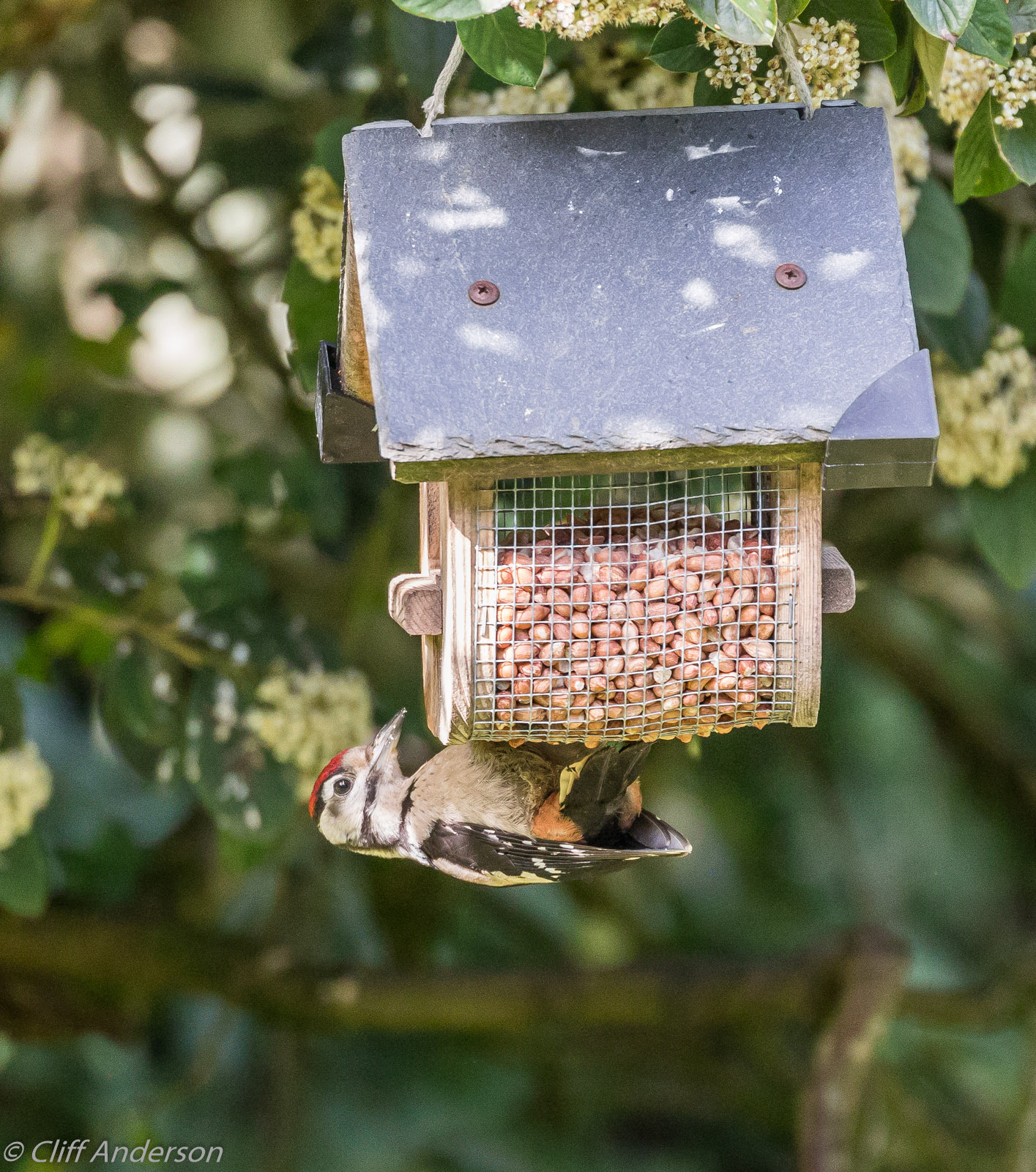
The big excitement for us this year was the appearances of a male adult great-spotted Woodpecker on the nut feeder. Excitement reached a new level when a juvenile, complete with red head, appeared later on. The expansion of these beautiful birds in Ireland continues 🙂

Baby Wren being stubborn!
Many other young birds brightened the gardens including Blue Tits, Rooks, Jackdaws, Goldfinch and more but the highlight for me was a family of wrens. One parent seemed to be in charge of 5 little divils that followed in the bushes but were always straggling, as the parent called to cajole them on.
Tenerife


There are many places with more wildlife than Tenerife but with the current restrictions due to the CV-19 Virus, I thought it might cheer us all up to think about somewhere warm and inviting!
And there are many birds and animals here although I confess that we were there for a short sunny holiday late last year 🙂 So the birds and animals in this post are those found easily – without using binoculars or spending hours in a hide. Also we were only on the West coast of the island.
If you walk around the shore you are almost certain to see many Red Rock Crabs. They are quite large and very colourful. This one, like most, was at the edge of the rocks waiting for the next wave to wash over him bringing tit-bits of food. 
There are a number of birds that can be seen elsewhere including waders like this Turnstone bathing in a pool on the rocks.
As an island off Africa, a boat trip is essential. I thoroughly recommend WWT – Whale Watch Tenerife. They have a fast rib with few passengers and are very knowledgeable and keen and care about the animals. There is a very good chance of seeing Short-finned Pilot Whales as the W coast of Tenerife is a favoured haunt. Dolphins, Sharks and Baleen Whales are also regularly seen.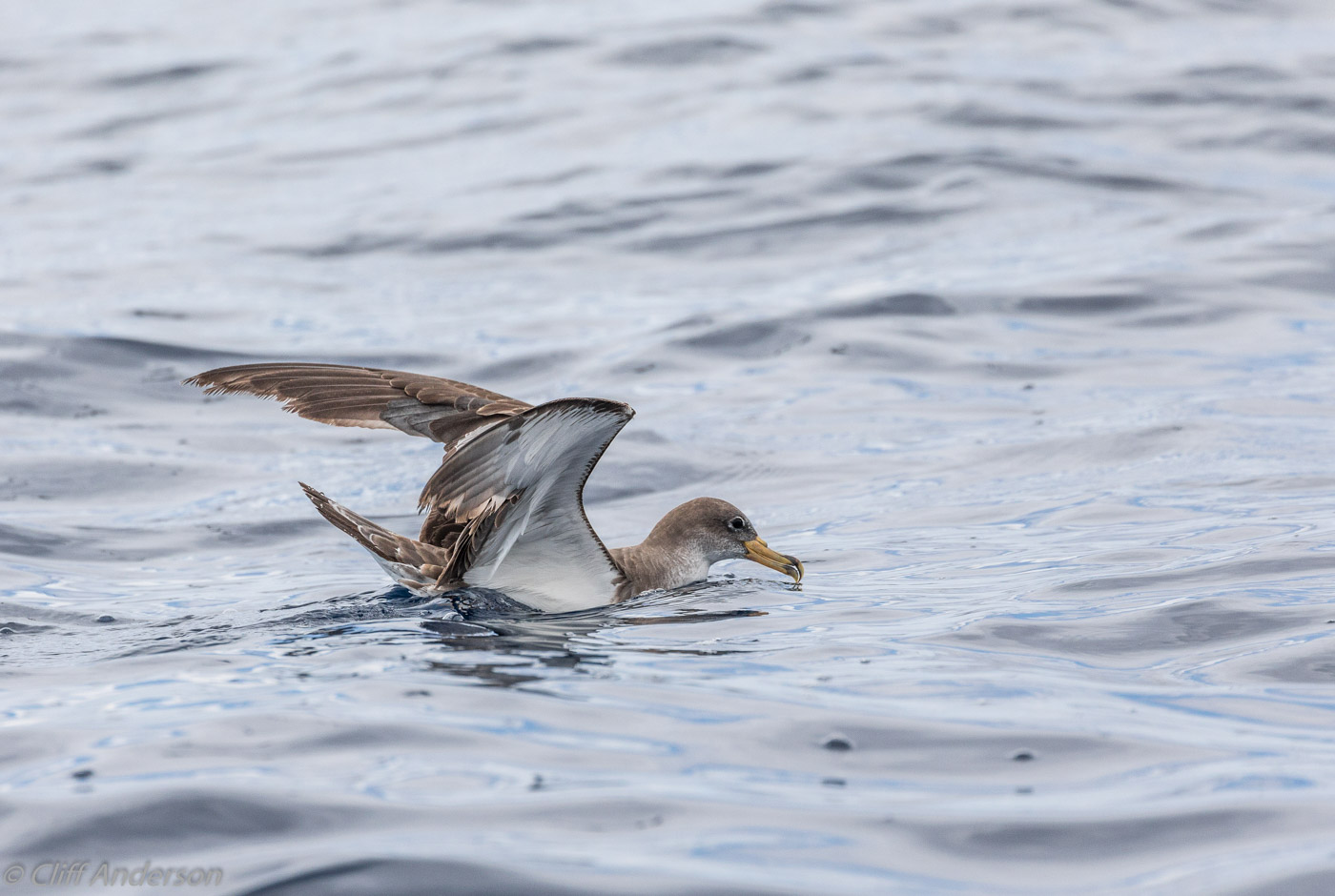
While enthralled by Dolphins and Whales, keep one eye open for birds. This is a Cory’s Shearwater which is quite common. It flies beautifully but looks a bit awkward in the water or on land – one landed on the path at our feet one evening!
Many of the harbours have large numbers of Flathead Grey Mullet swimming around the boats and shadows. Quite a few of the birds and animals are either species or subspecies endemic to the island or region. This is the Southern Tenerife Lizard (Gallotia galloti galloti) sun-bathing on the rocks along the coast.
Quite a few of the birds and animals are either species or subspecies endemic to the island or region. This is the Southern Tenerife Lizard (Gallotia galloti galloti) sun-bathing on the rocks along the coast.
Finally, there are nearly always Gulls. This is the Yellow-legged Gull, subspecies atlantis, found on Atlantic islands.
Stay safe.
Dublin – Looking Up


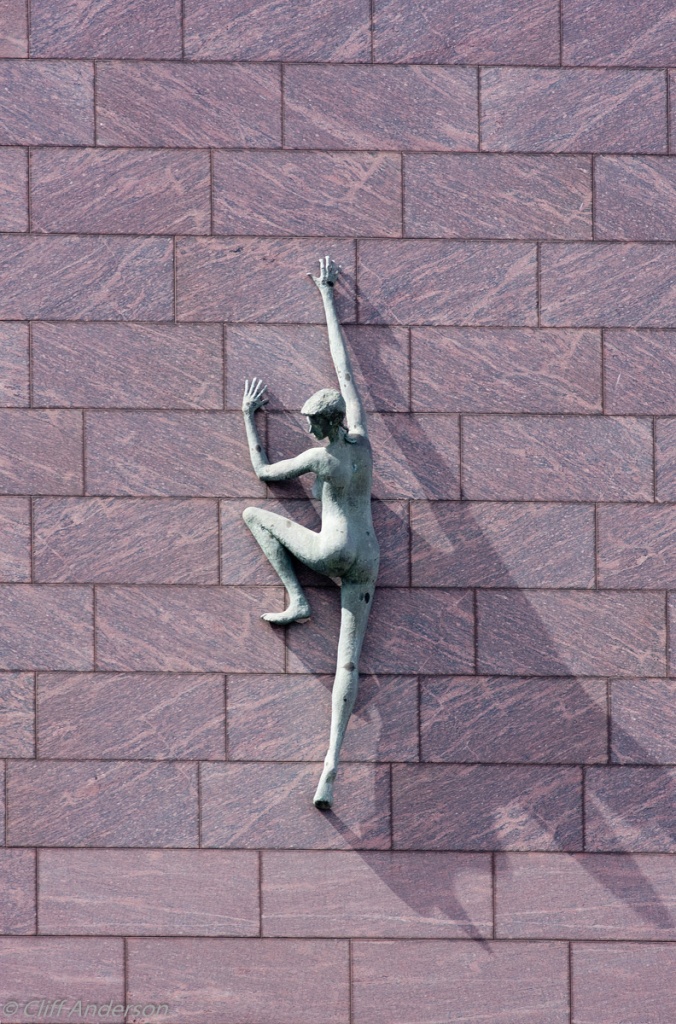 Its all too easy while walking or driving to keep your head down, eyes scanning for possible collisions, mind thinking of all sorts of things – troubles, dinner, family or just nothing. So perhaps its not surprising that we see so little of what is in plain view.
Its all too easy while walking or driving to keep your head down, eyes scanning for possible collisions, mind thinking of all sorts of things – troubles, dinner, family or just nothing. So perhaps its not surprising that we see so little of what is in plain view.
While on holidays, it is not as bad. Generally we are more relaxed and more open to seeing new things, exploring the surroundings.
However looking up is not too common, even on holidays. A shame as skies, architecture, spires, birds and so much more can be missed. Here I want to highlight some of the things that are easily missed by not actively looking, especially up, in Dublin.
The sky above is glowing red/orange after sunset. But look at the array of chimneys, Guinness silos, the Bottle Tower and the Church steeple, silhouetted against the sky. They are all interesting in their own way.
Ceilings are also often interesting – see 2014 post Ceilings https://cliffsview.wordpress.com/2014/06/28/ceilings/
It’s easy to miss the climber sculpture on the Treasury Building, Grand Canal St. Lower.
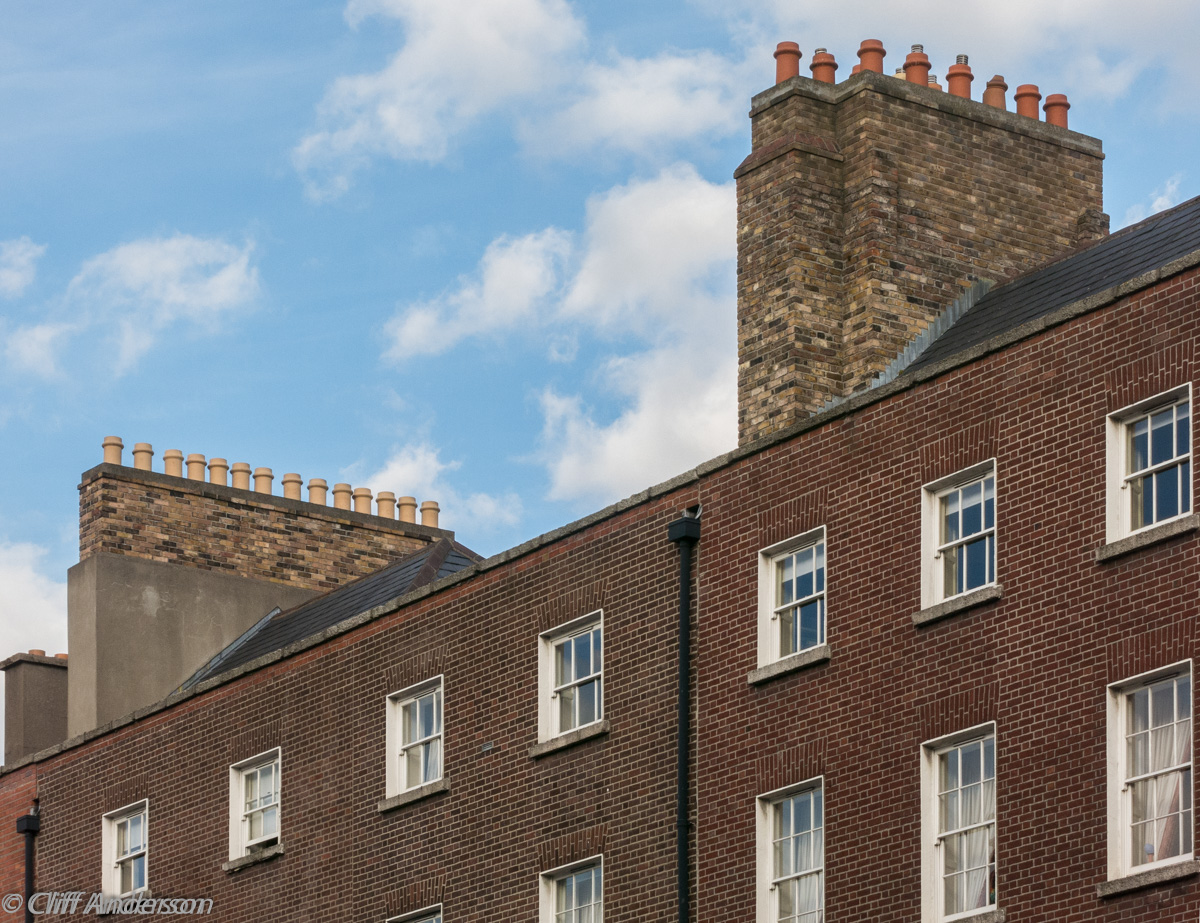
 Merrion Square is famous for its Georgian buildings with windows that get smaller towards the roof to emphasise height. But look at the battery of chimneys !
Merrion Square is famous for its Georgian buildings with windows that get smaller towards the roof to emphasise height. But look at the battery of chimneys !
And what about the Customs House?
The Copper Dome is a well known feature (although it is high up, it is very large and green) but have you noticed the dodgy looking statue on the top?
 This apparently is a figure of Commerce and includes an anchor!
This apparently is a figure of Commerce and includes an anchor!
Consider also the Justice Statue on the Gate to Dublin Castle at Cork Hill ?
She wields a heavy sword, balanced by a delicate scales! Hmmmm!
The huge red-bricked building enclosing Georges St. Arcade is a familiar site. However at ground level it is a bit dreary. Old premises are only beginning to be renewed and some remain empty.
Looking up reveals a great building with a fabulous roof-line complete with turrets, balustrade, attic windows and large elaborate chimneys. This is one of the special buildings in Dublin.


Dame Street and College Green contain a good number of interesting buildings. Once again though, the roof-line is often overlooked.
This is a great pity as a variety of intricate architectural features and designs are to be found way above street level.
The Roof Windows and lovely chimney with wind vane are on the old Hibernian Bank, now a H&M shop, while the Copper cone is on the red-bricked Bank Restaurant which used to be the Royal Bank of Ireland.
Probably this grand old tall chimney wouldn’t be missed if it was on a main street. Tucked in the back of Heytesbury St. is is less obvious but an interesting throwback.
It is octagonal, made of yellow and red bricks and was originally connected to the boilers in the old Meath Hospital.

Looking up at the Bank of Ireland in College Green reveals one of the old empire symbols – the Lion and the Unicorn. These are heraldic elements and appear on the coat of arms of the United Kingdom.
The figures are still looking in good shape though I don’t think the same could currently be said of the UK!
The same animals in a different pose appear above the Custom House on Custom House Quay along the Liffey. This time they look up to a Harp with a crown atop! This is not the Coat of Arms of King George III but that of the Kingdom of Ireland!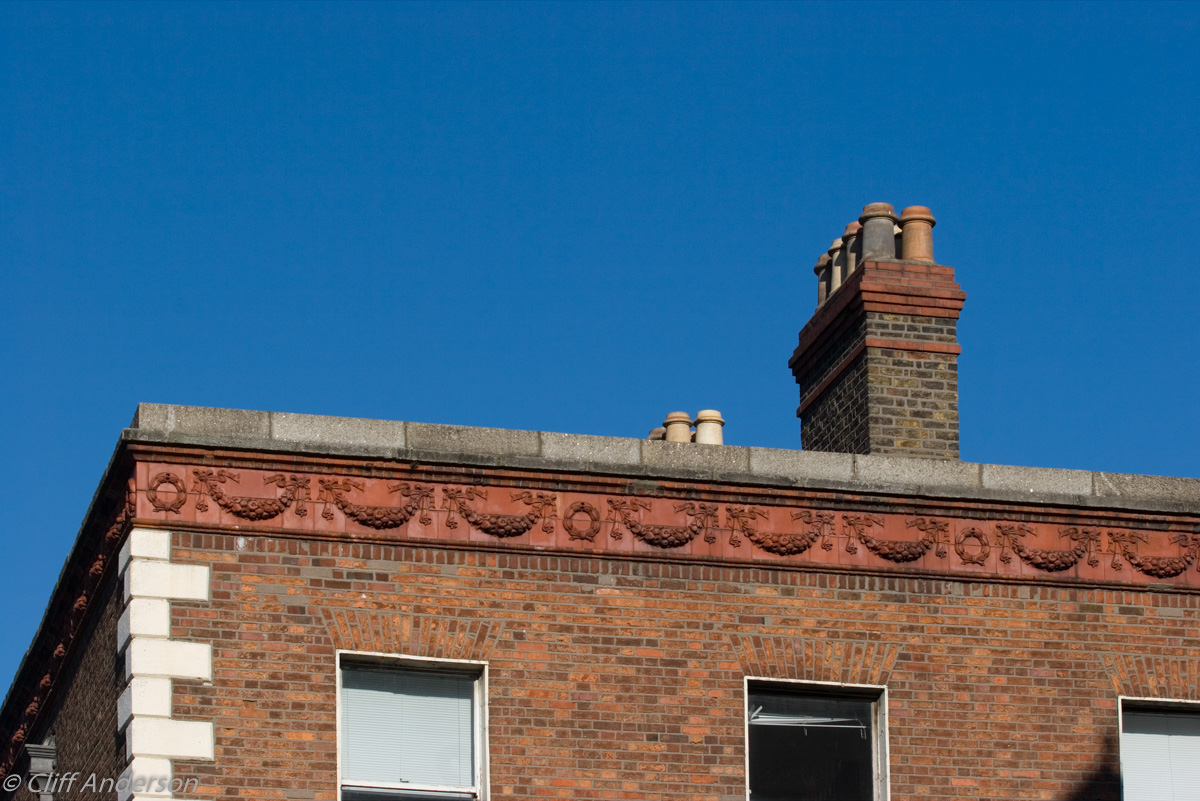
Decorative edging tiles under the roof of buildings on Lincoln Place.
Christ Church Cathedral contains a myriad of interesting details at street level as well as internally and even below ground (including a 58 metre long crypt). But still some some glances upwards are well rewarded. As well as some serious flying buttresses, there are cross finials, carved limestone parapets and octagonal tapering towers with windows.
 Finally a picture of Lord Edward Street looking down to Dame Street. Not to suggest that street level should be ignored in any way – Dublin has so much of interest in our old and some of our new buildings and features – but there is often so much of interest just a tilt of the neck away 🙂
Finally a picture of Lord Edward Street looking down to Dame Street. Not to suggest that street level should be ignored in any way – Dublin has so much of interest in our old and some of our new buildings and features – but there is often so much of interest just a tilt of the neck away 🙂
Blessington Basin


Hooded Merganser drake and Mandarin duck
It’s always great to have wild places in cities. This one is a super water oasis in the middle of Dublin. The ‘Blessington’ in the name comes not from the town in Wicklow but from Blessington Street, in Dublin. It is reached on one side from a linear park that used to be a canal, through a small gate in the surrounding stone wall.
This gives rise to its other name as ‘Secret Garden’. At the other end is a more salubrious entrance, gate and lodge, dating from 1811.
At the other end is a more salubrious entrance, gate and lodge, dating from 1811.
The ‘Basin’ itself is a fairly simple, rectangular tank with vertical walls and an island at its centre. This was originally built in 1810 as a water reservoir (The Royal George Reservoir) for Dubliners and was used by a number of whiskey makers into the 1970s. Restoration in the 1990s cleaned it up and it is now well visited by people and wildlife.
 Visiting from the secret end, the first wildlife encounter may well be a pigeon. Feral pigeons know how to find feeding spots and this is a good one with some very regular patrons. They will line up on railings and take off together at the slightest hint of danger or new food, with an alarming beat of wings.
Visiting from the secret end, the first wildlife encounter may well be a pigeon. Feral pigeons know how to find feeding spots and this is a good one with some very regular patrons. They will line up on railings and take off together at the slightest hint of danger or new food, with an alarming beat of wings.
 However the Basin often holds some surprising bird-life such as the Hooded Merganser drake and Mandarin duck in the top picture and the Wood duck above.
However the Basin often holds some surprising bird-life such as the Hooded Merganser drake and Mandarin duck in the top picture and the Wood duck above.
These are normally found in North America but have presumably found their way here after being discarded by collectors.

Immature Sparrowhawk in tree on the island
Keep an eye out for birds of prey – where there are birds feeding, predators lurk.
For me the star of this show was the male Hooded Merganser which just looks so proud and ‘kingly’, somehow beyond normal reality.
And that’s just what’s so fantastic about the Basin – it is a common haunt of locals and aficionados while at the same time an incredible revelation, haven and uplifting surprise for newbies.

Trinity Trees Tragedy

One of the fabulous Oregon Maple (Acer macrophyllum) trees of Library Square Trinity College Dublin. This was subject of a post in 2010:
https://cliffsview.wordpress.com/2011/02/21/review-2010-may
and the picture was subsequently used in an article by the Dublin Institute of Technology on the value of trees in the city; as well as on the front cover of the brochure for Environ 2014 – a conference on Environmental Challenges and Solutions held in Trinity in partnership with the ESAI.
Anyway that is all a bit beside the point which is that these were magical trees, tall with a wide spread. The picture is nothing compared to being near them. They were grand, had knurled, ancient, knobbly trunks and the sheer dominance of the trees, especially in Summer when the large leaves were in full glow, was inspiring. And their value to the city was great from their visual appeal and stress reduction capabilities to their Ozone and CO2 reducing abilities and Oxygen provision. It has also been shown that they reduce exhaust fumes particulates.
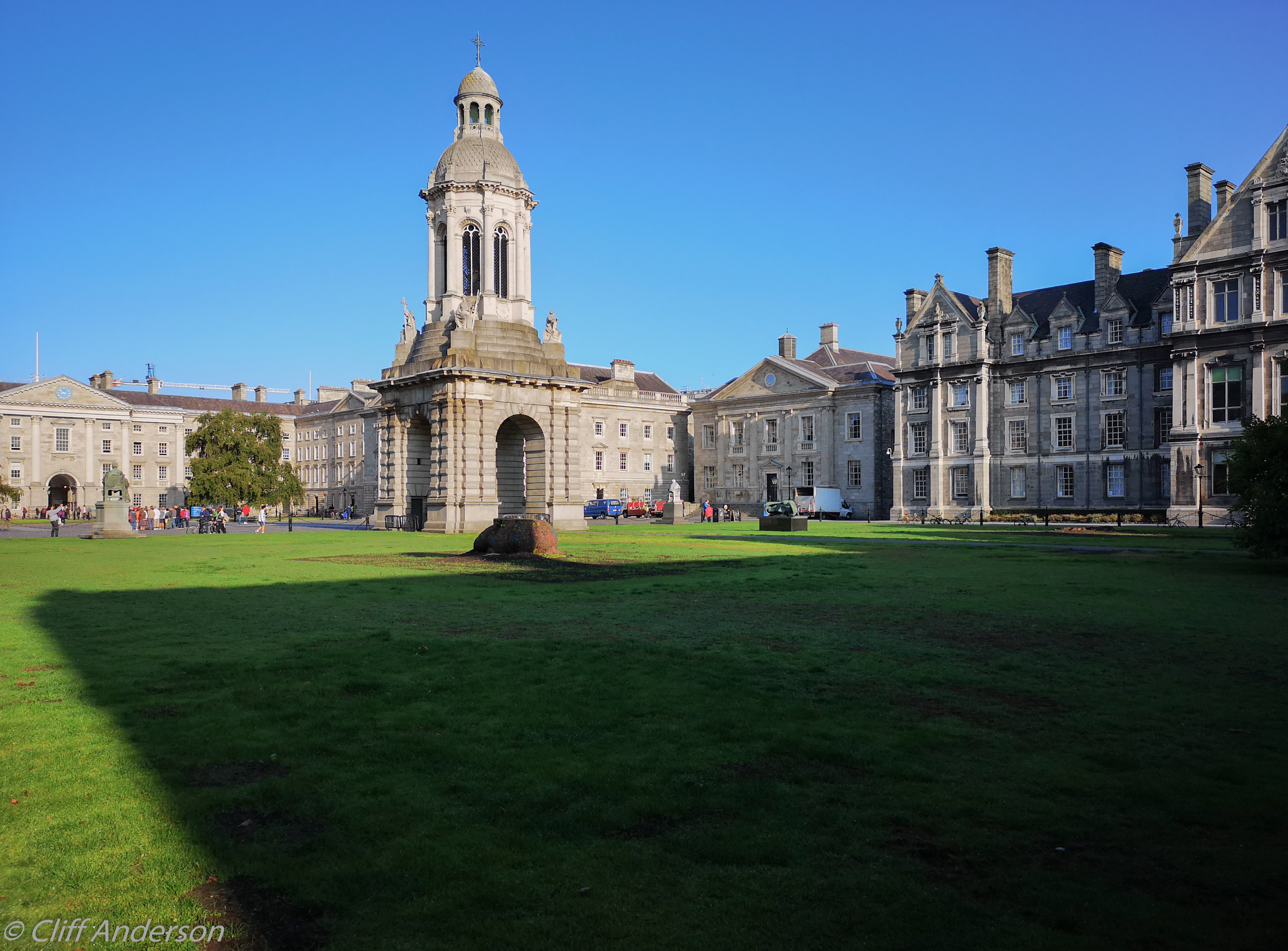
However this is the current view of Library Square from the Trinity Rubrics.
Only a couple of years ago we toasted our College education, decades before, in a marquee underneath the shade of these fabulous specimens. Trinity ball annually has a marquee there. The trees were checked recently for health and risk assessment. But soon after a very large branch of one crashed to the ground. Happily there were no human casualties but a reassessment found that the trees were rotting inside and they were taken down for safety.
 Of course there are many more fine trees in Trinity but these were special. Firstly they were magnificent, secondly they were very old – reckoned to have watched over Trinity students for about 175 years. What history and people and events must have happened here, within bough shot!
Of course there are many more fine trees in Trinity but these were special. Firstly they were magnificent, secondly they were very old – reckoned to have watched over Trinity students for about 175 years. What history and people and events must have happened here, within bough shot!
I will miss them. Thousands will. But so many more will never know what they missed. Let’s hope that they are replaced with trees of substance and character.
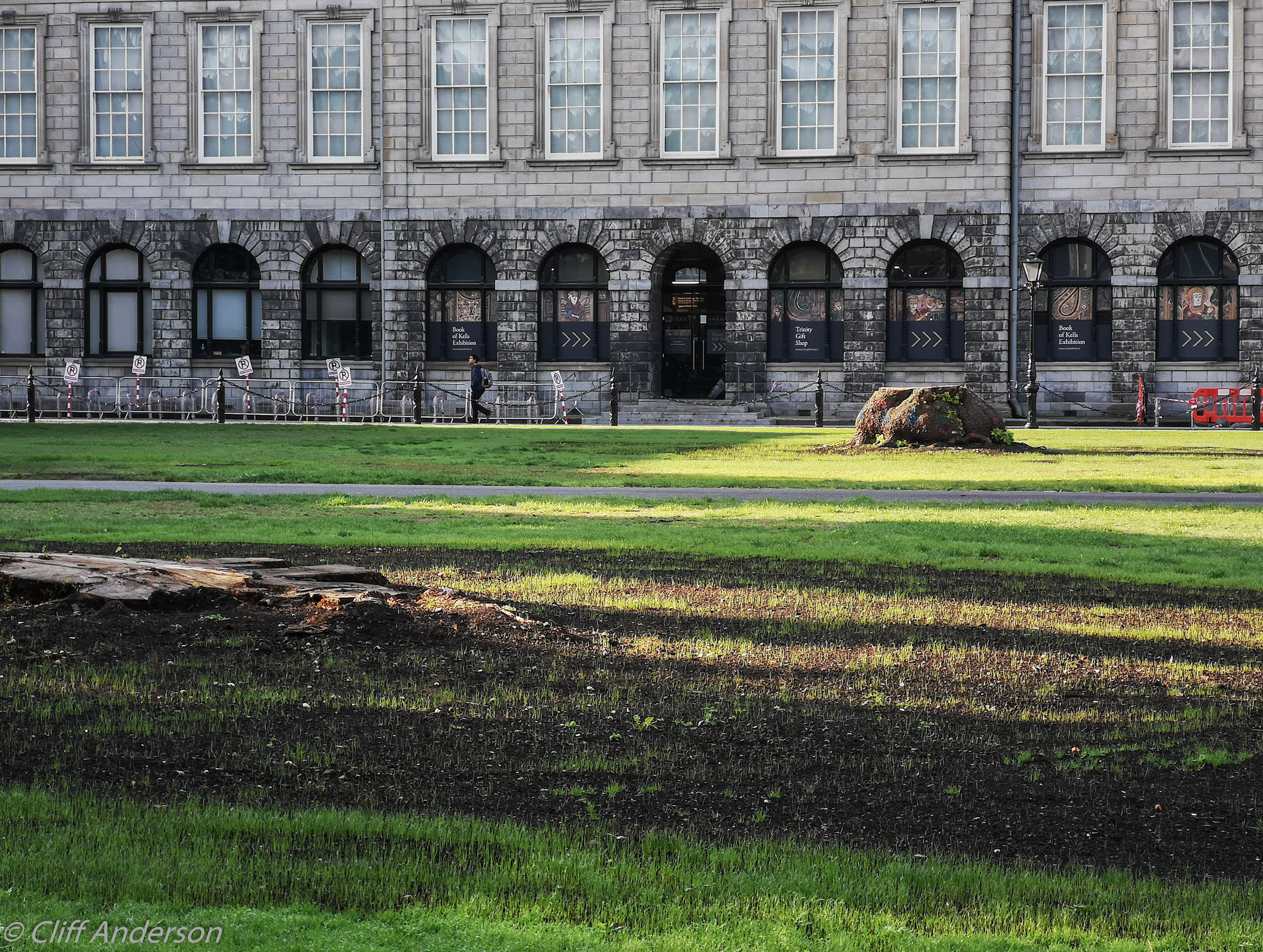
Snowed-in – New Neighbours
Have you ever walked through a marshy area and been shocked by a sudden explosion of feathers at your feet, which then disappeared off at full speed with a zig-zag flight? This is the culprit but I didn’t think we’d ever see one in our back garden!

Snipe walking in back garden
In fact we have 2 Snipe – a brace. They have discovered that amongst the acres and acres of deep snow around here, there is one spot where the the snow is thin enough for their long beaks to reach into the soil – our old trampoline!
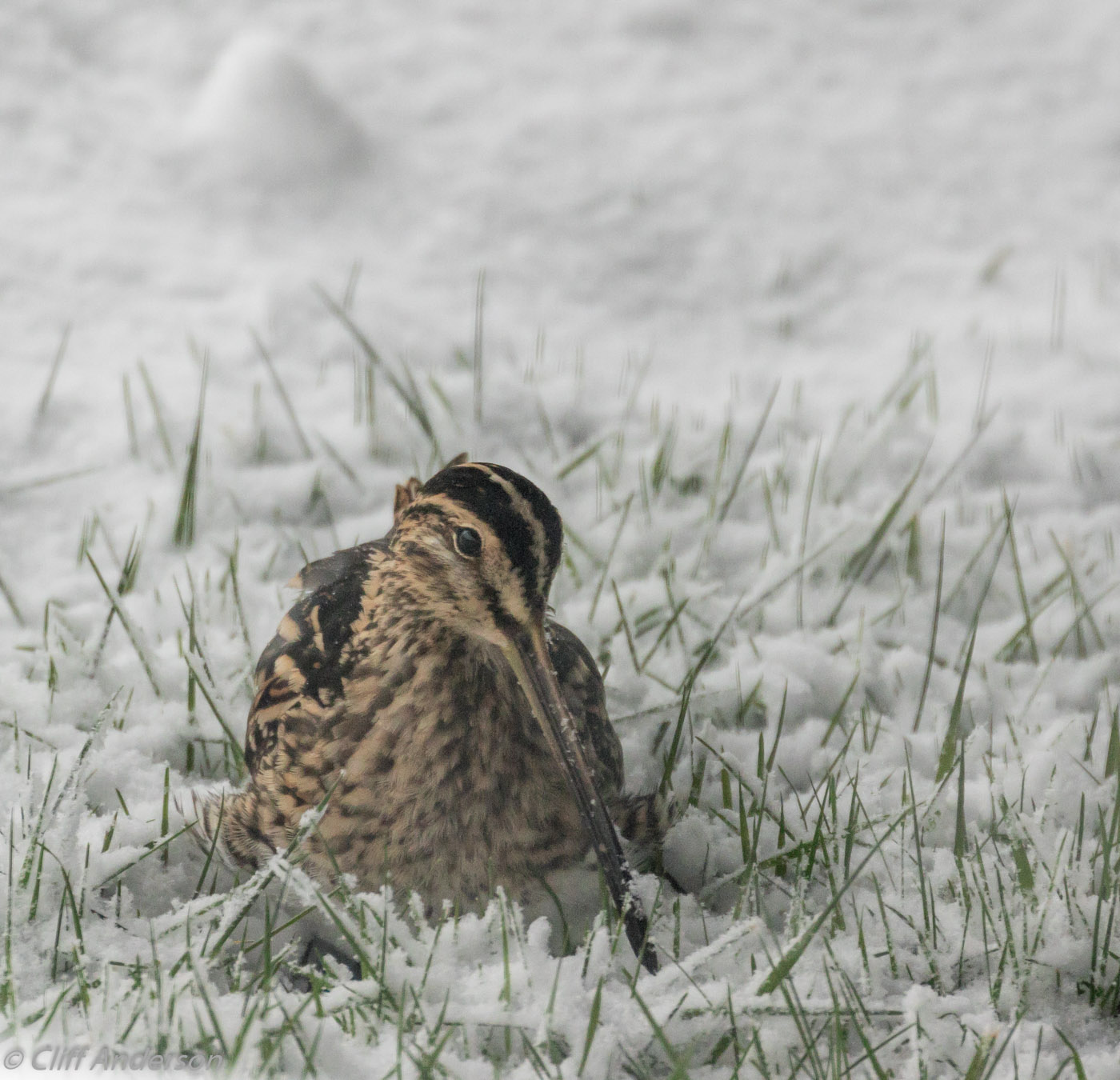
Snipe foraging under trampoline
There are a lot more birds in the garden than usual, drawn by the need to find food and by our feeders and seed strewn-steps etc. Today we had a Pied Wagtail our our doorstep.
It all looks cute and is great for close views of birds we seldom see close up but many birds will die during this spell. Indeed many people will suffer with some main and most side roads closed.
So be safe and help your neighbours – feathered and otherwise 🙂
Crows

 Some of the commonest and noisiest birds are in the crow family.
Some of the commonest and noisiest birds are in the crow family.
Found in most regions of the world they tend to be medium to large sized, intelligent, mainly blackish in colour and relatively brave around people.
Here in Ireland, the Jackdaw is one of the most visible members of the family which numbers approximately 40. Its white eye ring and mixture of black and grey feathers making it easily identifiable.



Slightly bigger are the Rooks which often mingle with Jackdaws.
They are much tougher looking and have a strong beak with a whitish patch at the base. They also show a dark blue tint when the sun shines.
They make untidy large nests in colonies known as rookeries, in the tops of trees in whereas the Jackdaws nest in holes, such as in trees or chimneys.
.
.
The biggest of our crows is the Raven with a wingspan of up to 1.3m. These are birds of higher ground, mostly scavenging on dead animals.
.
.
The other typical Grey-Black crow we have is the Hooded Crow. It is very similar to the Carrion Crow, found in England, which does not have any grey.
This is the main crow in many European continental countries.
Hooded Crow pairs nest on their own in tops of tall trees.

However, another common crow here is the Magpie – a really beautiful bird but with a bad reputation due to their success in towns and dominance over small birds.

Reasonably common but not seen as much is the Jay which has much less black in its plumage.
It is predominantly Brown with patches of blue, black and white and is most often seen in woods, particularly Oak woods.
The final Irish Corvid is the least known but possibly the most interesting and certainly my favourite. The Chough is similar in some ways to the Jackdaw but has red legs and beak. Also the beak is thinner and down curved – designed for poking into the ground.
The best places to see these are along the South and West coasts. They will probably be noticed first by their unusual ‘chough’ calls.
That’s a reasonable number of ‘Crows’ for a little country. In a blog to follow, some of the other crows will be highlighted.
Seville
 This is a really majestic, beautiful and fun city. The large complex Cathedral and magnificent Giralda tower in Plaza Virgen de los Reyes, together with so many other lovely buildings, could take most of your attention.
This is a really majestic, beautiful and fun city. The large complex Cathedral and magnificent Giralda tower in Plaza Virgen de los Reyes, together with so many other lovely buildings, could take most of your attention. 
These buildings include the Bishop’s Palace in the North of the Plaza

Reales Alcazares walled gardens
and the Royal Palaces, Reales Alcazares, to the South.
But Seville has much more and demands more time. It is not a place to be rushed and only a hint of Seville’s treasures can be shown here.

Plaza de Espana looking towards North Tower
 Further South still and nearer to the river, you’ll be flabbergasted by Plaza de Espana, stunning at night as much as by day!
Further South still and nearer to the river, you’ll be flabbergasted by Plaza de Espana, stunning at night as much as by day!
 And speaking of the river, a walk along the Guadalquivir is very relaxing with rowers and wildlife as well as other jewels including the Golden Tower and the Bull Ring, Plaza de Toros de la Maestranza.
And speaking of the river, a walk along the Guadalquivir is very relaxing with rowers and wildlife as well as other jewels including the Golden Tower and the Bull Ring, Plaza de Toros de la Maestranza.

Rowing under Triana or Isabel II bridge & Capilla Virgen del Carmen
It is hard not to see interesting buildings and the bridges are great in their own right.
 Beside Plaza de Espana, Maria Luisa Park is full of trees, ducks, water and offers some quiet and shade but it is very popular and busy.
Beside Plaza de Espana, Maria Luisa Park is full of trees, ducks, water and offers some quiet and shade but it is very popular and busy.

Metropole & San Pedro church Seville
Finally check out a few of the many quirky churches – many along very narrow streets and the Metropole, a sort of modern art city canopy with awalkway and great views from the honeycomb-like roof.
3 tips –
-

Spoonbill preening in Charco de la Boca lake El Rocio
It is a relatively short trip South to Donana National Park with Imperial Eagles, Peregrines, Azure-winged Magpies, Boar, Deer, Lizards and much more are to be seen or even shorter to Charco de la Boca lake at El Rocio where Glossy Ibis, Spoonbills, Egrets, Coot and many other birds thrive.
-

Mercado de triana Seville
This is a place that produces great food – enjoy.
 Should the unthinkable happen and it rains, explore the interiors of Reales Alcatras and the Cathedral – even if not religious you will come away uplifted! 🙂
Should the unthinkable happen and it rains, explore the interiors of Reales Alcatras and the Cathedral – even if not religious you will come away uplifted! 🙂
Saltees 2017


Gannets Greeting in Great Saltee colony over Egg in Nest
Great Saltee Island off the SE coast of Ireland is the place to go in May or June – or most times of the year.
But in early Summer the flowers and birds are terrific.
It seems to have its own micro-climate and has been kind, weather-wise, to us on our yearly pilgrimages.
We spent 4 or 5 hours on the island but could have spent 4 or 5 days without doing it justice.

Puffin taking off from Burrow with undelivered fish after disturbance
———————————————————-

Penthouse Suite – Kitiwakes nesting on cliff, Great Saltee
It is known best for its 2 Gannet colonies and for its Puffins but has so much more – birds such as Auks, Waders, Gulls, Cormorants, Choughs, Pipits etc. as well as Seals, Rabbits (inevitably), wild flowers and great views.
——————————————————–

Razorbill flying with fish

Baby Great-Black-backed Gulls in hiding – they will grow to become the marauding Lords of the island
.

Great Black-backed Gull in full marauding flight

Shag & Chicks in nest under Rock

Grey Seal immature in cave, Great Saltee

Gannet collecting vegetation for nest
.
.
The Gannets number over 2,000 and try to nest away from interference – one colony on a rock stack and the other at the extreme end of the island.
However over-enthusiastic visitors and camera holders constantly get too close, pushing the colony back and causing unnecessary stress and disturbance.
Gannets build a small mound of earth and vegetation – grass, seaweed, etc. – with more vegetation on top.

Gannet Nests with regular spacing
In such a crowded place, the Gannets are very regularly spaced. This is not so much about privacy for couples or respect for neighbours but rather fear of agression and use of agression to keep a small gap!
—————————————————-

Gannets fighting in colony
Fights do break out in the close noisy turmoil.

Gannet returning to nest in colony, Great Saltee
Gannets mostly look all the same to us but presumably they can see distinct differences and hear different calls. Nevertheless finding one’s mate in a large noisy colony can’t be easy and landing amongst defensive neighbours in wind has to be difficult.

Gannet head – with superior attitude
.
.
A magnificent bird and beautifully designed for life on the sea and for diving into the water from a height.
 Puffin calling from rock amongst Pinks on clifftop, Great Saltee
Puffin calling from rock amongst Pinks on clifftop, Great Saltee

- Puffin with Sandeels
.
.
Hard to ignore the gorgeous, cute little Puffins though.
Puffin numbers go up and down yearly based mainly on the numbers of Sandeels available.
The last 2 years seem to have been fairly good but of course fish numbers worldwide are only fractions of 100 years ago due to over fishing, pollution, human interference and now, particularly plastics – hard to imagine such a happy state for our seas now 😦

Puffin flying in
Costa Rica

Green Iguana, Tortuguero
A long wish-list sleeper was ticked off this year with a great trip to Costa Rica. The country is small, about the same size as Ireland but there the comparisons seem to end.
It has kept many of its forests and regrown many others. It has a great variety of habitats and features – highlands, beach, mountains, cloud forest, rain forest, mangroves ….And it has both Caribbean and Pacific shores!
Best of all for wildlife enthusiasts, it has brilliant birds, animals and plants. Over a few posts, I hope to show a sample of these.
Let’s start with some common birds and animals.
While Crows, Starlings and the odd Buzzard might act as scavengers in these parts, in Costa Rica they are replaced mainly by Black and Turkey Vultures and Grackles

Turkey Vulture
The vultures can be seen in the skies all over the country and it feels strange to hear them described as ‘only’ vultures!

Great Kiskadee
A hot country with rain, breeds loads of insects which spawn many flycatchers. One of the commonest is the Great Kiskadee, seen on wires in all regions.

Anhinga (male), Tortuguero
The rivers and canals are home to many species including the ancient Anhingas, often seen drying their wings. This one looks like a rock star.

Green Heron, near Manuel Antonio NP
Many herons can be seen waiting patiently for a fish to come close.

American Crocodile sun bathing, Tortuguero
Rivers are not for the faint-hearted. They host snakes, Caiman and Crocs that are way beyond ancient!

Male Mantled Howler Monkey on roof, Tortuguero
Meanwhile the trees are home to 4 different types of Monkeys. Nosiest of these is the Howlers whch have a habit of waking people at dawn with their deep growling howls, produced by large throat balloons.

White-faced Capuchin Monkeys eating Palm fruit, Osa Pensinsula
The cheekiest monkeys are the Capuchins which have learnt to rob food from tourists but ‘normally’ eat fruit and small animals.

Hoffman’s 2-toed Sloth
Its also in the trees that Sloths can be seen. It’s hard to believe how hard it can be to see such big slow moving creatures.
It can be hard to see both large and small mammals but Agoutis and Coatis can usuallly be seen with a bit of patience. And Squirrels often come close.

Variegated Squirrel, Monteverde Cloud Forest
This can only be a quick look at the common wildlife in Costa Rica but more will appear in subsequent posts. Let’s leave with one of the iconic birds of the region – the Hummingbird – as well as bright flowers which are also a big feature of beautiful Costa Rica.
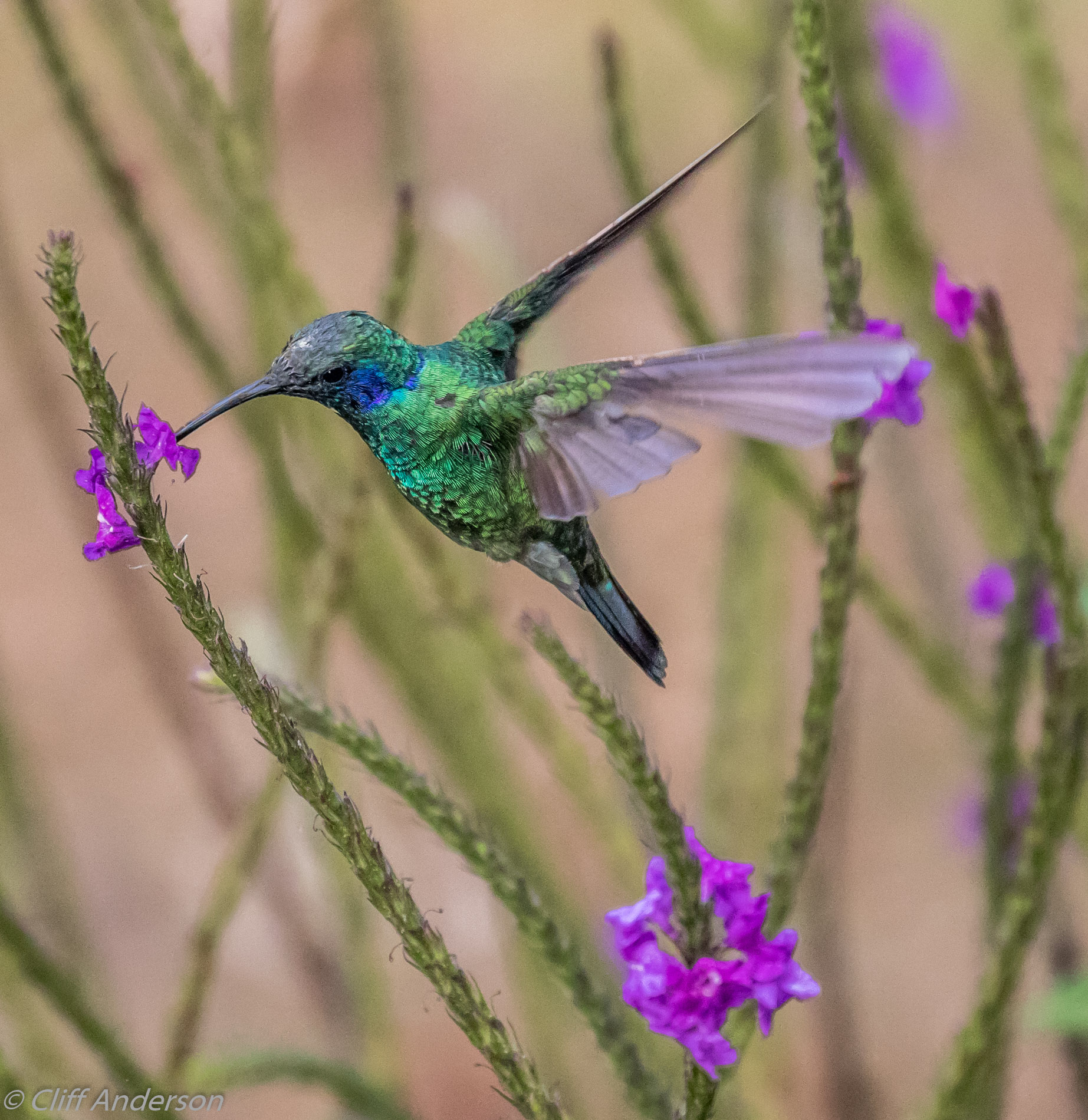
Green Violetear Hummingbird feeding on flowers, Monteverde
Spring or Late Winter

The 1st of February is Lá Fhéile Bríde (St. Brigid’s Day) and traditionally welcomes Spring.

Tree Split, Lough Dan
This year the ‘Winter’ was so mild that the usual flocks of Greylag Geese and Whooper Swans only made brief appearances in the fields around us. ‘Spring’ seems to be wet, cold and windy in comparison! Storms Doris and Ewan were not appreciated, ripping rooves, felling trees, disrupting Electricity service and ruining golf scores.

Mallard Drake walking on thin Ice, Frensham Little Pond, Surrey
The birds and animals have been ‘twichy’ – a bit like the bird watchers – for some time but many people associate the onset of Spring more with March or April and around here the worst weather of the year offen hits us in February or even March.

R-otary Club Crocuses, Stephen’s Green, Dublin
Anyway the weather generally does seem to have been milder in recent years, no doubt a product of the climate change that politicians and many businesses around the world refuse to tackle. It is easy to be pessimistic about the future when you couple this with radicals being elected to parliaments and higher stations around the world (trying to be polite as this includes murderers and nut cases) and the increasing violence and war threat.
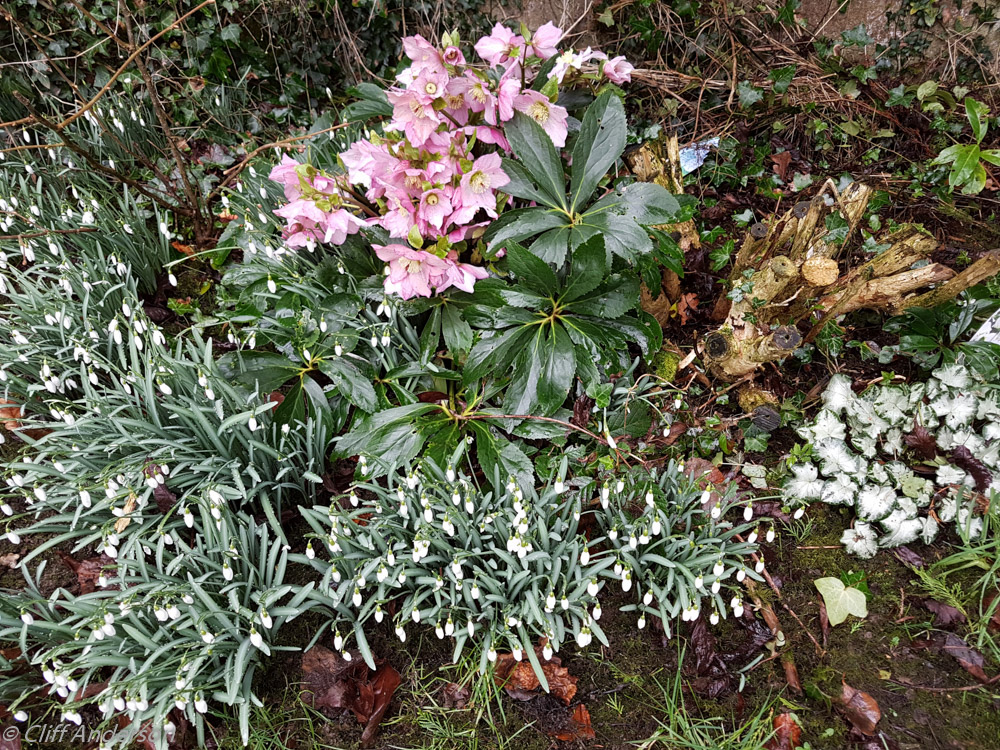
Snowdrops & Helibores in Garden
Keeping the happy face on, the usual early flowers have risen – Crocuses, Snowdrops, Helibores etc. – and Daffodills are starting here although much more developed in the capital. Garden flowers such as Viburnum Bodnantense, flowered over winter as usual, improving the fragrance of the neighbourhood.
On another note completely, Sika Deer seem to be thriving in Ireland. Deer generally are too numerous and suffer official culls but Sika seem to appear much more commonly recently.

Sika Deer, Trooperstown Wood, Wicklow
What is really required is a reintroduction of Wolves – the 4 legged kind, we have plenty of the others. Reading a great book, Feral, by George Monbiot, I was delighted to see the case for apex predators was well made. It always seemed to me that the ‘wild’ here was badly skewed and marginalised. Monbiot argues convincingly that a bottom up approach to diversity and conservation is much less successful than a top down, apex predator approach along with relieving our mountains from the catastrophies of sheep farming.
Here’s to better action from our politicians on the environment (and hopefully, more immediately, improving weather and some sun !)
2016 Review

Another good year and the current mild weather is encouraging for a good 2017.
Old favourites were highlights again – Cold weather at the start of the year didn’t put off Harry the Heron in Saint Stephen’s Green, here trying to swallow a large fish.

Harry in St. Stephen’s Green with Fish – Roach perhaps
Spring brought early flowers including the usual Crocuses, Snowdrops, Daffodils and Helebores as well as more cultivated plants – all providing sustenance for the early insects.

Skimmia Japonica Rubella flower buds
In gardens and parks, birds were excited, feeding eagerly for the nesting season.

Robin eating Worm in St. Stephen’s Green, Dublin

Coal Tit in back garden
Many walks were taken. One of the nicest is in Durrow, Co. Laois. A couple of good walks taking in Castle Durrow and the Erkina river as well as woods and fields, are great for relaxation, exercise and nature.

Durrow Castle & Estate
Summer brought our annual pilgrimage to Great Saltee Island. Puffins and Gannets were numerous but the island hosts thousands of other birds as well as eye catching displays of wild flowers.
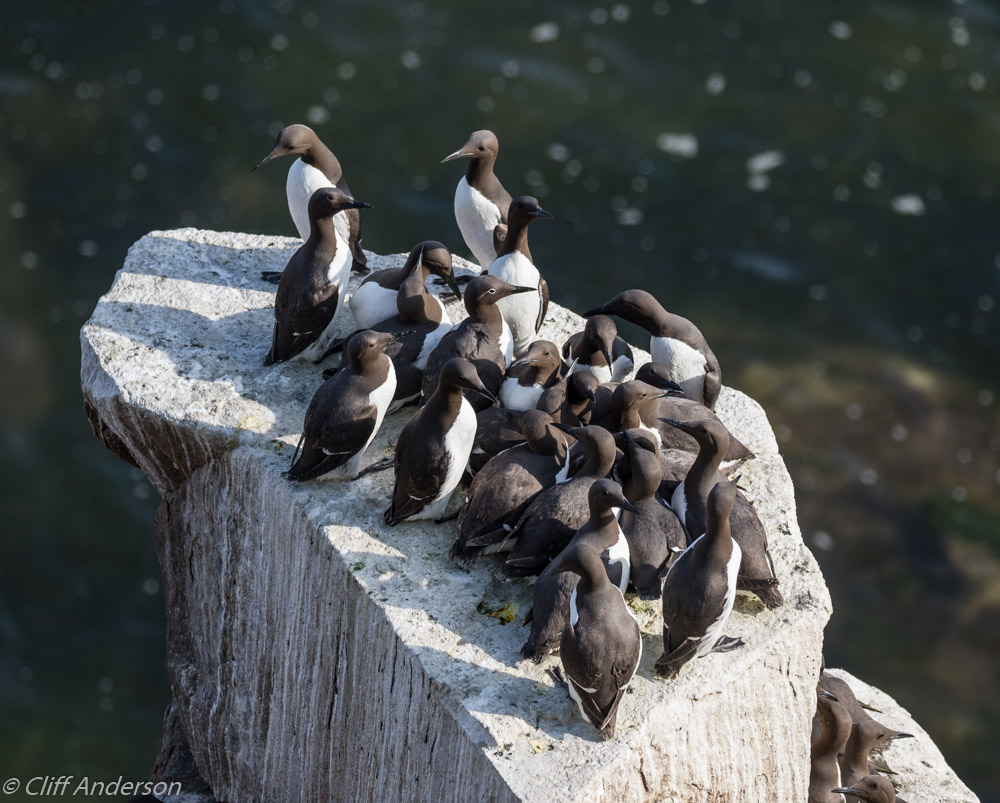
Guillemots including Bridled variety on Rock Stack, Great Saltee
Beside the river Liffey, Coronation Plantation looked well in Summer sun.

Coronation Plantation, Co. Wicklow
Back in St. Stephen’s Green – did I mention what a great place this is, in the middle of the capital city! Of course I did but it really is 🙂 – Swan, Duck, Pigeon and even Sparrowhawk chicks were thriving.

Mother Tufted Duck with growing juniors St. Stephen’s Green
Other good Summer walks took us to Carlow where we were rewarded with a glorious sunny wheat field with wild poppies around the edge and

Wheat Field with Poppies, Carlow
back to my old North-side where Sutton at low tide revealed waders and gulls and great views.

Worm Casts on Sutton Beach and Ireland’s Eye

Squabbling M&F Red Deer, Killarney NP
We visited Killarney in August and people and clouds were once again dominant 😦 Someday we will get good weather but not that time. The scenery was still stunning and we saw a good deal of wildlife including a lot of Red Deer, including 2 that seemed to be boxing! ——————-

Silver-washed Fritillary butterfly, Killarney NP
The year did not seem to be great for Butterflies but this beauty appeared in Killarney National Park.
——————————————— Deer were again in focus in the Autumn in Phoenix Park, Dublin, where the annual rut saw stags strutting their stuff and sometimes clashing in head-jarring fights with rivals hoping to claim the ‘rights’ to a particular group of Does.

Fallow Deer Rut master bellowing over Does, Phoenix Park
Climbing Croagh Patrick mountain gave brilliant views over Clew bay, islands and Baltra strand. We also had a great cycle ride.

Clew Bay & Baltra Strand from Croagh Patrick
Wildlife around Westport included Great-Northern Loons (which used to be called Divers) and pleanty of waders. A wren foraged continuously in the trees and bushes and around old rusty pillars

Wren at Old Head, Mayo
.All that sea produced lots of Seaweed in a variety of colours and patterns.

Seaweed at Old Head, Mayo
The colours in Ireland in Autumn and early Winter are often taken for granted but it is worth getting out, particularly on those magical, crisp, clear days to walk, look, listen and just soak-up the scenery.

Autumn Leaves Shankill River, Wicklow
Frost appeared early mornings late in the year and that coupled with an enduring cold / flu, curtailed golf a bit but the lakes looked stunning on calm days – the course too with a partial frost covering.

Calm Blessington Lakes from Tulfarris
After Christmas over eating, we felt obliged to take a decent walk and revisited Seefin mountain in the Dublin / Wicklow range. The cairn on top covers a 5000 year old Neolithic passage Tomb and the view from 621 metres up is well worth the strain and cold.

Cairn over Neolithic Tomb on top of Seefin Mountain
A few trips were also taken to fine places in other countries but other posts will have to deal with those as it’s time to wish everyone a
Happy 2017.
Autumn Passing


Autumn Colours and Shankill river, Wicklow
Didn’t seem to last long but Autumn has given way to Winter. While the weather was good this year, already the temperature has taken a dive. Hopefully the great colours of the falling leaves were enjoyed by many.
.
.
It was a busy time in many ways. Apart from loads of photos to be takem, an old oil tank acting as a coal bunker needed to be removed (partly to make way for a new Water Butt and auto solar-powered watering system – but that’s another story) and it revealed a teeming environment of ‘low life’.

Snails, slugs, spiders and other creepy crawlies behind old bunker
Not everyone’s cup of tea, so to speak, but it’s amazing what lives and dies beyond our normal gaze.
.
Interesting contrast between these two pictures, don’t you think!

Young Moorhen scavenging – St Stephen’s Green Dublin
.
.
Autumn is the time that many young birds start to fend for themselves, entering another dangerous period of their short lives.
Moorhen often feed on droppings and other bits and pieces lying around as this young one was in St. Stephen’s Green, Dublin.
.
.
.
.
.
.

Great Northern Loon or Diver, Clew Bay, Mayo
.
.
.
Autumn is also one of the main migration times as thousands of birds leave and arrive in search of more suitable conditions. Twitchers will have been covering the miles to catch sight of unusual birds and rarities.
If not at the twitcher stage, it is still worth looking out for birds and sea creatures from our

Red-throated Loon, Clew Bay, Mayo
shores.
We recently saw both Great Northern and Red-throated Loons while strolling along the beach in Clew Bay, county Mayo.
Theses used to be called Divers in Europe. They were in transitionary plumage – half way between breeding and Winter plumage.
Loons or Divers are large duck-like birds sometimes confused with cormorants from a distance. They can stay underwater for a few minutes at a time during which you need to predict where they will surface.
.
.
.
.
.

Rut Master calling in woods of Phoenix Park, Dublin

Younger Fallow Deer Stags practice fight, Phoenix Park
Autumn and early Winter is the rutting time for some deer species in this part of the world.
Right on Dubliners’ doorsteps, the Phoenix Park hosts several groups of Fallow deer. They have been there for a few hundred years since they were placed for the hunting classes.
During the rut, Stags compete to have mating rights with groups of does. This involves a lot of posturing, gutteral calls and some fighting using their prodigious antlers (which while impressive and photogenic, otherwise seem to be a bit of a nuisance, catching in grass and branches).

Rut Master Stag with Does, Phoenix Park
Damage is sometimes done but mostly common sense prevails and the strongest (or most confident or biggest bluffer) prevails.
Fights can be witnessed – they often take place in the woods while the does sit and wait in the fields. Young stags also practice fight which is a much more relaxed affair.
It is not a good idea to approach too closely at this testosterone charged time. Indeed too many people get too close all year to animals that should be left wild. Many also feed them bread, Mars bars and all sorts of stuff best left outside the park.

Red Toadstool – Fly agaric – Clara Vale, Wicklow
.
This is what it is all about – a contented if tired stag with ‘his’ hopefully content and fruitful does!
.
.
.
Plants usually provide the most colourful and showy Autumn sights.
But it is not just the dying leaves – whose often brilliant colours are caused by the closing down of chlorophyll, resulting in the green leaves changing to a range of yellow to orange and red colours – that are notable.
Many plants show confident colour at this time. For example Crocuses and shrubs such as Verbena often flower brightly and some with lovely scent.
Mushrooms also can be colourful although generally in nature, the most colourful are the most dangerous! This one is said to be poisonous although rarely seems to kill humans. It also has hallucinogenic properties.
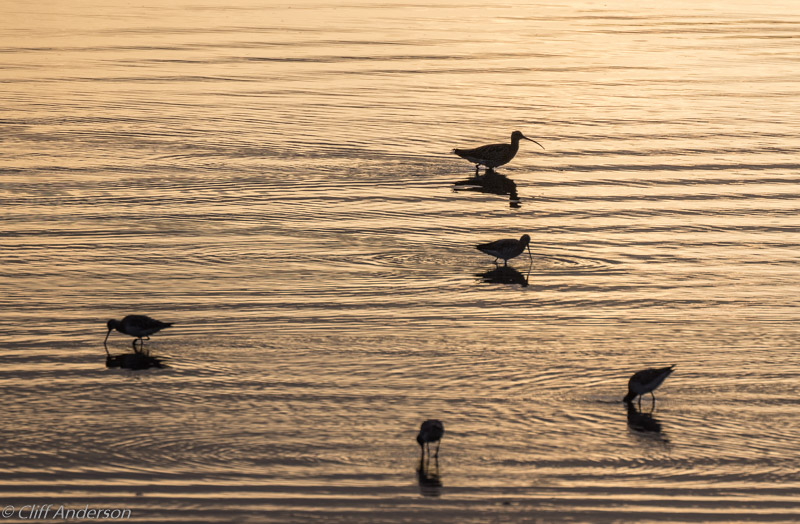
Curlew & Godwits against morning sun, Baltra beach,Mayo
Finally, this is the season of the wader. Coasts everywhere are greeting larger and larger flocks and Geese and Swans are on their way, including ‘ours’, hopefully.
.
The message as always is if you can get out there, well, GET OUT THERE.
Happy Winter
Paper Houses – Wasp Magic
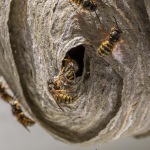
Wasps, like spiders, divide people. They can cause pandemonium or can be admired.

Norwegian Wasps on Nest under our roof
As part of my case for admiring, consider their house building skills and team work. The picture above is of a partly built nest just discovered under our soffit, attached to TV cables. These are Norwegian Wasps, one of 6 species of social (meaning they are not solitary, rather than that they will have a chat with us!) wasps in Ireland.

Norwegian Wasps building Nest under roof
These nests are built, bit by intricate bit, by the wasps chewing wood into a pulp and pasting it into place at the nest.
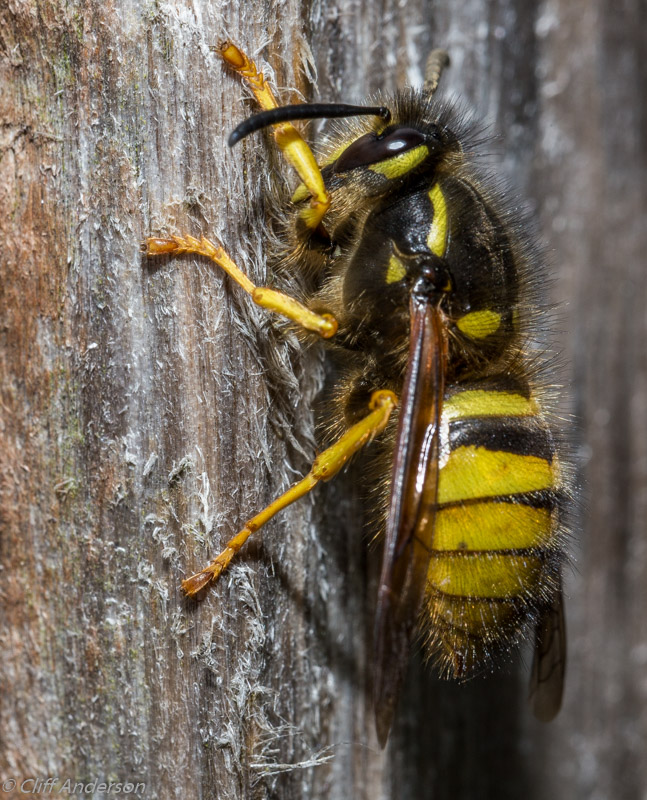
Tree Wasp chewing on garden shed
The Tree Wasp above was found in early June nibbling away at the wood of our already weathered, garden shed.
The nest is started by the Queen and extended by the worker wasps produced. The inner construction is a honeycomb shape with hexaganol cells where the eggs are laid and the wasp larvae grow.

Yellow Paper Wasps working on nest, Santa Cruz
The picture above from the Galapagos Islands shows the early cells with eggs of Yellow Paper Wasps. And below is a similar example from Spain, showing the stem (Petiole) stuck to the leaf by the Queen.

Wasp nest under Palm leaf, Malaga, Spain
Another nest in construction, this time by Paper Wasps (Polistes gallicus), near Montepulciano in Tuscany.

Paper Wasps building nest on back of sign post, Italy
Outside these cells, a number of cover lobes are constructed so that the nest ends up in a roughly round shape with an entrace hole near the bottom.
Common and German Wasps are said to be more common. They usually build their larger nests underground.
It can be difficult to identify different wasp species, especially if their faces are buried in flowers or you are concentrating more on getting out of the way! However each species has distinctive black marks on the back and face. This is a bit complicated by variations amongst Queens,Workers and Males.

Wasps & nest under large leaf, Ecuador
These paper houses can be found all over the world, varying in shape size and rigidity. The wasps are also quite adaptable. A few years ago Tree wasps adopted a Tit Nest Box to host their nest.

Tree Wasps building nest in Tit box, Front Garden

Tree Wasps extending nest to partially cover Tit nest box hole

Tree Wasp guarding entrance to nest in Tit nest box
Surely one of the wonders of the world! 🙂
Goodbye Lizzie, Hello Caoimhe
Looking like a small alien blob, it takes a while to recognise the tiny baby birds huddled together for warmth in a small nest.
In previous years Lizzie had rared families of Blue Tits but last year our camera nest box stayed idle, despite a brief bout of grass depositing.
This year we hadn’t seen any movement near the box and on the infrequent times we had checked the video, there was nothing happening, although again, some grass had been collected early on. This month we checked again just to be sure there was nothing there. In another nest box, with no camera, wasps had built a nest a few years back. Anyway we were surprised and delighted to realise that not only was there a nest but there were eggs – very small oval shaped eggs with few markings and a slight pink tinge, although this could have been caused by the light reflecting off the wooden box.
Only about a week later, we saw one of the birds seemingly breaking an egg. But as she moved, the strange outline of a fleshy, scrawny, awkward baby could be seen. The parent was actually getting rid of the broken egg.
Now there are at least six babies. There could be 7 or even 8 – they tend to sit on each other in the confined nest hollow. There were 8 eggs, so maybe all hatched safely – more to find out!
Welcome Caoimhe.
Spring 16


Crocus in Garden
While many in Ireland are commemorating the 100th anniversary of the Easter rising, plants have been rising in fields and gardens as for ever.
Crocuses, Daffodils, Primroses and Snowrops are the early bloomers, bringing colour & promise.

Snowdrop in Garden
Other flowers to test the temperature early are the Hellebores. Like all the others, they provive nectar for the early flying insects.

Hellebore Flower
Most of these are waning now as the main shrubs and plants take over. However here in the cold foothills of Wicklow, everything starts later and some are still hanging on.
Frost is still a threat and some flowers, like sleepy teenagers, look very different from early morning …….
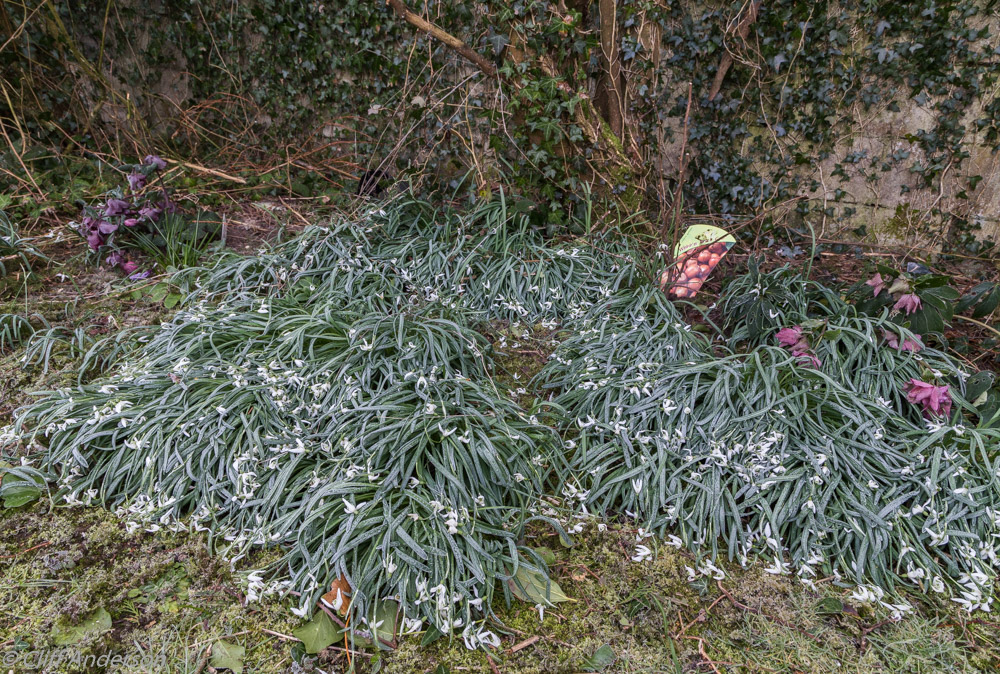
Snowdrops & Hellebores Drooping in early frost
to afternoon!

Snowdrops & Hellebores Awake
2015 Review
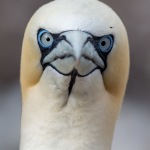

Sorrell Hill from Lugnagun

Canon EOS 7D ready for new careful owner
Looking back 2015 was a mixed year, starting cold and ending with the wettest weather that I can remember. In between there were decent warm and dry spells and from my perspective, at least, a good year for wild things and places.
January started cold with plenty of Finch flocks, particularly Goldfinch around the lakes.
Small flocks of flighty, restless Long-tailed tits tested my camera and patience and Redwing & Fieldfare appeared as usual. (Winter Birds)
It was a good time for walks and enjoying the clear winter air and views. Lugnagun is one of our favourites offering views of the Lakes on one side and the mountains on the other with chances to see Ravens and small birds and perhaps Peregrines.
It was also the time to sell and upgrade my trusty 7D camera which had served very well for years.
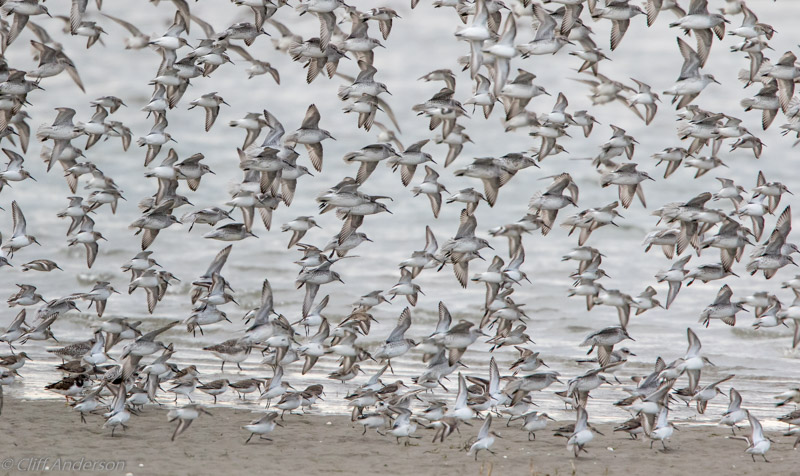
Dunlin Flock, Bull Lagoon, Dublin
February showed signs of Spring but it was our old haunt, the North Bull Island, that brought fondest memories. Many hours have bben spent here in the past when it was on my doorstep. Now it is a good journey but always rewarding.
Thousands of waders were there as usual, as well as Brent Geese and ducks such as Shellduck and Teal.
For me, the huge, wheeling flocks of waders in the sky when they are disturbed, beats any sight in Dublin.

Mute Swan with attitude, Kensington Gardens, London
.
.
.
March saw various creatures getting ready for the amorous season.
This Swan in Kensington Gardens in London seemed to have an extra dose of hormones.
He chased anything that moved and many that hadn’t intended to, seeing off all and sundry, including large Canada Geese, just for being there.

Rat sniffing air outside home, Russborough
.
.
.
.
.
.
.
.
.
Nearer home, a rat had made the base of a tree into a complex home with a network of paths and exits.

Wren on branch
.
Regularly hated, shunned and feared, these are interesting creatures and not in any way ugly to my eyes, although they are associated with a number of human diseases.
.
.
.
.
.
.
.
.
.
.
.
.
Along with blooming plants, the nesting season accelerated in April. Birds marked their territories by singing and despite being tiny, this little guy sang with the best of them – an unmistakeable high-pitched song to brighten any day.

Howth Head view of Bull Island to Lambay Island
.
.
.
.
.
May is the official start of Summer. Flowers that had brightened Spring, spread and developed and showed the countryside at its best.
Howth Head is a great place to visit in May (or most months) and is a favourite trip of ours.
It may be unique in displaying such a diversity of scenes and habitats in such a snall area, still bustling with human life.
To the North is the well-known busy harbour with restaurants, fishing industry, Gulls and Seals.
A brilliant walk takes you all round the cliffs or up over the top of the head. The cliffs host seabird ‘towns’ – vast numbers of closely nesting Auks, Fulmars, Kittiwakes and Cormorants – while the head hosts many lovely small birds, such as Wheatear and Stonechat.

Gannet Stare, Great Saltee Island
.
.
.
.
.
.
.
.
.
.
The Saltees welcomed us for our annual visit in June.
A bit like Howth only more remote, quieter and with better weather, this is an absolutely brilliant Island.

Puffins Courting and Bill-clacking on cliff edge, Great Saltee
Thousands of seabirds, lovely wild flowers and an island away from it all – what’s not to like?
However it is a toss-up as which of 2 birds is the greatest attraction – Gannets or Puffins.
Both are magnicifent. The gannets nest in great numbers – one of the most important sites in Europe, while the tiny Puffins vary in number each year, depending on the availability of Sand Eels.
But they are strikingly coloured and impossibly cute.
Apart from the sea birds, the island also had Choughs and Gull species as well as Oystercatchers.

Heath Spotted Orchid, Pollardstown Fen, Kildare
.
.
.
.
.
.
.
.
.
.
.
.
.
.
.
.
.
.
.
.
Pollardstown Fen in County Kildare was visited in July.
Fed by a spring, this marsh area is now designated as a Special Area of Conservation.
It has an old feeder canal to the Grand Canal and was important to that transport system.
Many different plants and animals can be found there including a number of Orchids and a car park, path and boardwalk make access easy.

Green Vervet Monkey, Nairobi National Park
.
.
.
.
.
.
.
.
.
.
.
.
.
.
Business required a visit to Nairobi in Kenya in August and, well, you can’t go there even for a short time without seeing some African wildlife!
Nairobi National Park is not huge and lacks quite a few animals, such as elephants, that had to be removed for their safety.
But it is very close to the city and has Rhinos, Zebra, Lions, and many other animals and birds.
The Green monkeys are cheeky and get quite close.
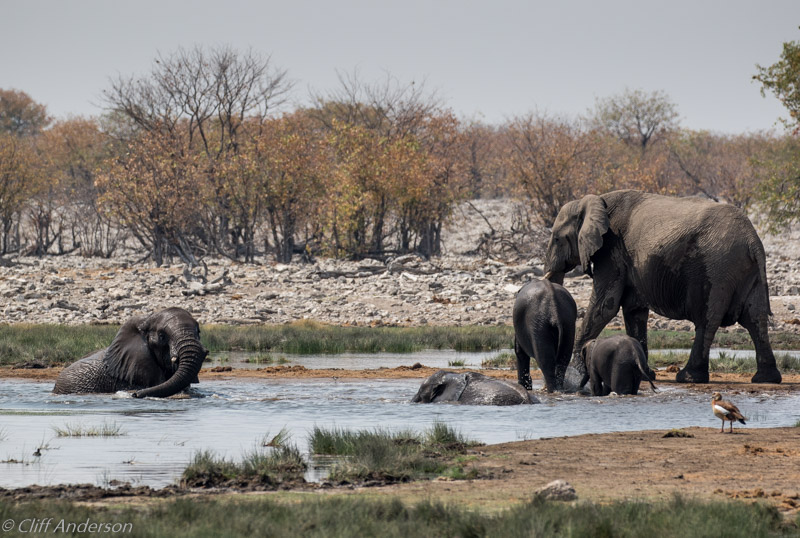
Elephants bathing and playing in pool, Etosha National Park Namibia
.
.
.
.
September saw most of the Summer birds and animals still around – butterflies in the garden, terns at the coast, etc.
But holidays took us back to Africa on a brilliant trip from Victoria Falls to Cape Town.
Amongst so many sights, we took in Chobe and Etosha National Parks, the dunes and deserts of Namibia and Penguins in South Africa.
So many mammals and birds but particularly, many many elephants.
A great trip in great company.

Autumn Colours Mount Usher gardens
Water levels in the lakes were quite low in October which saw little rainfall – quite unlike the end of the year! Now if there could just be some storage scheme to even it out (and maybe have the rain fall at night!) :).
Autumn colours predominated and few places show this better than Mount Usher gardens.
Apart from the foreign trees and plants, there are many native species and the Vartry river flows peacefully through.
Also Butterflies, Herons, Dippers and Wagtails, amongst others, are regularly seen.

Tufted Duck male, St. Stephens Green, Dublin
.
We had a wedding in November and a number of visitors, so it seemed a more indoors time than outdoors.
But life in the great outside continued as normal, where the mild weather was well appreciated, especially by the smaller birds.
St. Stephen’s Green in Dublin, one of my regular walks, seemed to be back near to Spring levels with Ducks back in full plumage and Swans and Pigeons being fed (although too much bread, I fear).
Tufted Ducks dived and preened and water rolled off them like worries should for us.

Wigeon feeding in Rogerstown estuary
.
.
.
.
.
.
Rogerstown estuary in North Dublin is a very good birding site with a tidal estuary, bird hides and some pools and a wooded area.
In December it was teeming with ducks and waders including Wigeon, Teal, Shelduck, Pink-footed Geese, Redshank, Greenshank and Lapwing.
There were also Peregrines and Buzzards. Not bad for one site.
As the tide receeded, hundreds of mostly Wigeon, formed a line along the diminishing channel as the light became more and more golden. Hard to leave.

Sunken Boats on Blessington Lakes at Russborough
Christmas came and went with more parties! The weather outside however was stormy and rainy with many places flooded. The only good part was that it remained warmer than usual.
With cold weather creeping in, I wish everyone a great 2016.
Spider Behaviour

There’s been a bit of a gap since the last post – maybe a sign of a good Summer?

Delicate touch – Spider Tetragnatha extensa on web in flowers
Those of you squeamish about Arachnids should maybe wait a bit longer – this is the second part of a Spider feature, dealing more with behaviour. The previous post can be found here – Spiders in Ireland.
The first thing we think of regarding spiders is Webs. Apart from having 8 legs and numerous eyes, this is a very defining deature. The first picture shows the delicte, sure touch of the spider as well as the strength of the silk lines it weaves.

Spider’s Web in frost

Raindrops on tiny web
Sometimes webs are hard to see – they are used to trap flies afterall – but frost, rain and morning dew makes them very visible.
Then the brilliant structures and their number, can be admired by all.

Dew-covered Webs on bush

Female Garden spider – Araneus diadematus underside showing spinners
Spiders have spinners under their rear (see picture and also Garden Spider showing spinners), from where tough silk emerges quite rapidly.
In fact spiders can produce different grades of fibres for different uses – web, temporary scaffold for making web, wrapping prey, cocoons etc – and use different glues.

Male Garden Spider in web – waiting, feeling

Spider Meta segmentata female dragging cranefly in web
Spiders wait quietly and still on their webs with their legs on a number of lines, or at the edge of a web, perhaps under a leaf, but touching a main line, waiting for vibrattions that tell them some prey is struggling with the sticky web. However spiders themselves are able to traverse the web very quickly. This seems to be due to a number of factors:-
- spiders know where the sticky strands are
- spiders have an oily substance on their legs which resists sticking
- they walk in a way that minimises the contact between the glue drops and the tiny hairs on their legs and
- they have a third claw that seems to work with the flexible hairs to grasp the thread and release it!
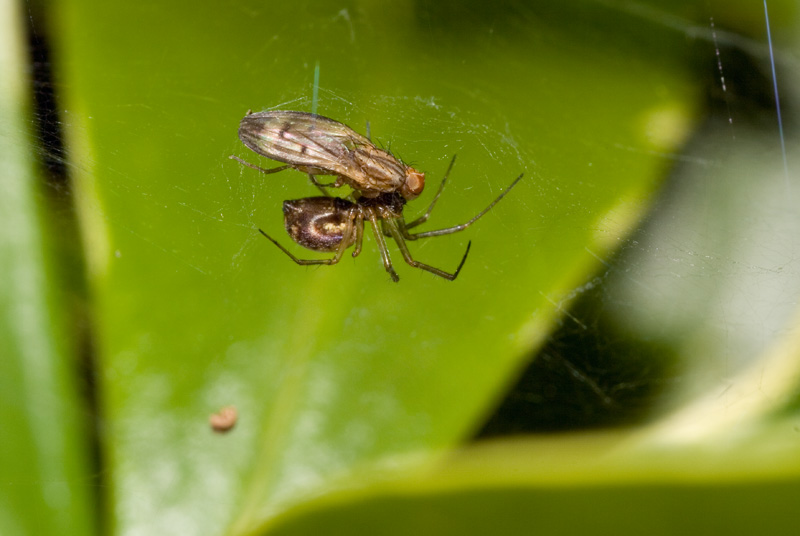
Fly caught by spider- linyphiidae
Prey stuck in a web, is usually doomed unless large and powerful enough to free itself. The resident spider usually approaches quite quickly and ends the struggle with a poisonous bite.

Male Spider Tetragnatha extensa cocooning prey in web
Generally the spider then cocoons its prey using more sticky silk thread – dinner for later.
Although it seems out of character, some spiders do not build webs. Hunter spiders (Hunter Spider), for example, use speed to grab and bite their prey.
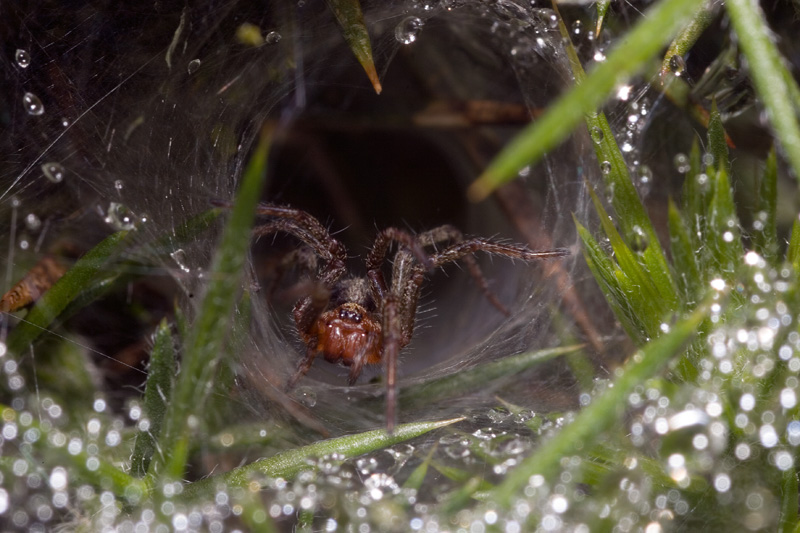
Spider in web Lough Dan
Another use for spider silk is to make funnels and nests.

Spider Tetragnatha extensa on stem
Finally, spider silk is used to make a sac to carry its eggs.
.
.
.
.
.
.
.
Spiders are good at hiding, whether it is in the shadow under leaves or in the open, staying still.
.
.
This is aided by aligning their legs with the foliage …
.
.
or by looking un-spider-like and staying still.

Harvestman on house wall
Life & Death

The last few weeks brought home the faster life and death nature of wildlife. Not that all of us don’t have to go through the same things, but generally we seem to have a more intense and drawn out experience to death. I was watching a TV documentary on elephants where they seem to mourn and dwell over dead friends and relatives a bit more like us – something I had read about before – and there are the elephant graveyard stories. However smaller animals and birds ‘appear’ to treat death as a sharp shock before getting on with their lives.
Alternately, it might be the frequency of death, rather than the size of the animal, that lessens its effect on others. Years ago our company used to train technical staff from an African country.
They came on a series of courses and we got quite fond of some that had been to Ireland on a few occasions.
Asking casually about one such that was not on the course being taught at that time, we were told, fairly matter-of-factly that he was ‘gone’. We had to pursue this to understand that he had died (of aids which kills so many in Africa).
These morbid thoughts are brought on by a few sightings during last month.
1) We had a Song thrush nest in a partial wild hedge in our back garden. The young seemed very healthy and not disturbed by the sound of the lawn-mower going past very close – admittedly not as often as it would do in a tidy garden. I was late in discovering them and reckoned by their size and activity, that they were close to fledging. The parents continued to bring them food and to rest in the nest overnight, keeping them warm. Two days later, when I looked, they were gone but not just the chicks, all trace of the nest was gone! There had been some wind but not as much as previously, so either they flew and demolished the nest in their leaving or, probably more likely, a cat got them.
.
.
.
2) Relations of ours have a Blue Tit camera nest-box similar to ours, that this year finally produced a nest, eggs and eventually young.
Their joy at the constant feeding and attention shown by the parents was brought to a shuddering halt by their sudden disappearence.
The babies continued to call for food but as time went by, it became clear that the parents were not coming back and that the chicks would not survive.
Cats are the main suspects although it is strange that both parents ‘disappeared’.
.
.
.
.
3) While walking in the rain along the river in Tomnafinnoge Wood near Tinahely (this is a very special woods and features Oak trees and Woodpeckers and the River Derry, a tributary of the Slaney), I heard a commotion from behind.
It sounded like a bird in a panic flying towards me but as I looked around with the camera un-ready!, it turned out to be an Irish Stoat (often called a Weasel here but actually there are no real Weasels in Ireland) running towards me. While still trying to get the camera settings into appropriate action, I realised it had something in its mouth. I thought it was a bird but on later review of the poor pictures, decided it was a Wood Mouse.
Aware that I would dearly want to get a good picture of this startling scene, the Stoat turned and jumped into the undergrowth!
The animal is gorgeous – very small and beautifully coloured – a kind of fawn / beige brown – and with a white belly and a black tip to its tail.
However the bird in its mouth broke the thought of innocent beauty and brought home the lethal nature of nature.
.
.
.
4) This week I walked along the Grand Canal in Dublin, thronged by lunch-time walkers and those eating food from the vendors along the banks. As usual, I was looking for birds in the margins and eventually found a Moorhen amongst the reeds. Going to the bridge I could see that it was building a nest and as I got closer again, a chick appeared from under the parent’s wing! In fact there were 3 chicks and at least one unhatched egg. Moorhens often have 8 eggs so there may have been more.
The other parent regularly brought leaves that (s)he knitted into the nest. This was necessary as the nest was a floating one and required constant attention to keep it above water. Both Moorhen sexes incubate the eggs and they are indistinguishable without examination. However the male is understood to do most of the nest sitting.
On the far side of the canal, a young Heron stood patiently by the water’s edge unconcerned by people behind him, much closer than normally consider comfortable.
In the nest, little Johhnie – there’s always one – climbed out and swam about on its own. He may have done this before but the parent on the nest did not seem too pleased while the other parent was pre-occupied with leaf gathering.
While I watched the Moorhen’s knitting abilities, someone behind me was feeding pigeons. They wanted to peck at the large bread crumbs thrown and constantly pitched the crumbs up in the air as they tried to break them. This led the crumbs and them to get very close to me. So close that I nearly missed the drama.
A Lesser Black-backed Gull, which presumably had been watching the crumb throwing, also had his eye on the Moorhen Nest and suddenly flew down. The parent jumped up to attack it and defend the nest but as the Moorhen pecked at its neck, the Gull, in one movement, reached down, grabbed a chick in its beak and disengaged from the fight, flying to the other side of the canal with the unfortunate chick in its bill.
This was not little Johnie, the mischievious roamer but one of the goodie-goodies that stayed in the nest – it’s the same the world over!
This all took about a second or two. Too quick for yours truly, unprofessional, unprepared and a bit stunned, to get a picture of the scrap.
On the far bank, the Lesser Black-backed Gull manoeuvred the chick a couple of times and then swallowed it, as a few people and the Moorhens looked on disbelievingly.
After a few minutes, the Moorhen sat back on the nest with little movement. It seemed to be detrermined to shield and protect the remaining brood & egg(s). I was left wondering if (s)he continued to dwell on the incident, to be sad or to mourn.
A couple of days later, the nest was gone. Only floating leaves remained. It may be that the remaining eggs hatched and the young went off with the parents. On the other hand, the nest was close to the bank, in a place frequented by people and the Canal in its city stretches, features many predators including dogs, foxes and of course little (and big) brats!
Looking forward to more on the ‘Life’ side in the next few weeks.
The Flowers that Bloom in the Spring …

With apologies to Messrs Gilbert & Sullivan, these flowers have everything to do with this case.
.
The traditional show in Altamount Gardens, Co. Carlow, was brilliant with different varieties and areas where the lawn was almost obscured by white. . See https://cliffsview.wordpress.com/2015/02/22/spring-signs/
.
.
Spring Signs

Cold it’s been but February has brought brighter evenings and other hints of Spring.
.
.
.
First of all there are lambs about. Some very early and eager young bits of wool appeared much earlier but the serious production has now begun.
.
.
.
.
.
.
.
.
.
.
.
Mother ewes can be seen watching and protecting their little darlings who seem wider in the back legs at this stage – presumably to give more balance.
.
.
.
Definitely one of the cuter signs of Spring.
.
.
.
.
.
Another traditional sign is the appearance of Snowdrops.
Gardens, parks and scrap ground all over Ireland are showing Snowdrops in full bloom. Last year Snowdrops flowered earlier than the previous 40 years but I did hear a murmur that they were declining. You certainly wouldn’t guess that from the many on show.
The Snowdrop (common version – Galanthus nivalis) grows from a bulb and has become naturalised in Ireland from garden escapees, although it is native to many European countries.
.
.
.
.
.
.
A great place to see them is Altamont Gardens – a public gardens in Carlow, that apart from being a beautiful place with loads of plants and trees in a great setting, has a display of many different varieties. There are supposed to be more than 100 varieties there, though I didn’t count them! It also has access to one of Ireland’s loveliest rivers, the Slaney.
Although other varieties and species are interesting, I am happy with our common or garden Snowdrop and there are thousands of them in Altamont.
.
.
.
.
.
.
Meanwhile, in Phoenix Park, Fallow Deer are divided into male and female groups.
The young stags are practice fighting ahead of the rutting season much later in the year. In fact the ‘clacking’ sounds as they test their impressive young head-gear against each other, can be heard for quite a distance even the though they are relatively well hidden in the trees.
It is a great priviledge to be able to see such behaviour within a walk from the city. Those pointed antlers look like I wouldn’t want them anywhere my eyes or head!
.
.
.
.
The group of does seemed much calmer.
.
.
Strangely they showed no signs of wanting to start a fight 🙂
.
.
Here’s to a calm spring and great nesting season.
Winter Birds
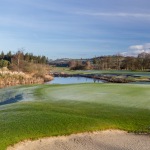
We’ve had frost, snow, winds and rain but it hasn’t been a bad winter so far.
Of course golf hasn’t always been possible!
.
Birds have had a mixed time. There has been a good deal of wild fruit on trees and on the ground and people these days put out more food in gardens.
On the other hand, some of those aweful shrubs with ‘lasting’ berries (meaning that birds don’t like them, which makes them close to useless in my book) have begun to see some bird harvesting.
.
Whooper Swans and Greylag Geese still visit the fields beside our garden.
See previous post – ( https://wordpress.com/post/14866330/2493/ )
.
.
In the garden, Fieldfare and Redwing arrived in December.
These thrushes are in the same family as the more familiar Song Thrush, Mistle Thrush and Blackbird but arrive in some numbers here only in winter from Scandinavia.
They are definite signs of cold weather if that’s not already obvious.
The Fieldfare is pretty much Mistle thrush size and has a grey look.
.
.
.
.
.
.
.
.
.
The Redwing is closer to Song Thrush size and appearance but has a red patch under its wings.
Both can be a bit shy and scare off easily.
.
.
.
.
.
.
.
.
.
.
The Fieldfares love the fallen Crab Apples in our front garden. Strangely we usually get a bumper crop of these every second year and were not expecting them again this year. They still came and fell in large numbers which attracted the Fieldfares as well as the more common and less shy Chaffinches and Blackbirds.
.
.
.
.
.
.
.
.
.
.
Down at the lakes I heard and then saw a large flock of Goldfinches (Charm, Drum or Troubling of Goldfinches according to ‘Birds of Ireland, Facts, Folklore & History). There must have been at least 50 birds making quite a racket as they attacked the cones high in the Larch trees beside the lake. They moved quite fast, making them difficult to photograph and showed good agility.
.
.
.
.
.
.
.
.
.
.
Also close to the lake, a flock of Long-tailed Tits flitted amongst the trees
They also move quite fast and don’t stay in one tree too long.
It is an unfortunate fact that Ireland has a much smaller number of bird spesies than the UK – who in turn have a much smaller selection than the continent. We miss out on some really cute members of the Paridae family, such as Crested, Marsh and Bearded Tits.
However the Long-tailed is one of the most beautiful birds in Ireland with its long tail and pinkish feathers.
Its nest if you ever find one (not easy), is beautifully constructed in a tree from moss and spider webs, with a small entry hole – something to keep an eye out for in spring.
.
.
.
.
.
.
.
.
.
.
.
.
.
Finally, checking out the lake near Russborough House, this Heron was happily fishing away. He (or she) didn’t seem to be catching anything large but seemed to have plenty of small successes. The prey looked like insects.
Hopefully the rest of the winter will be as enjoyable.




































